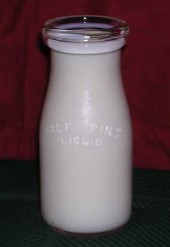
| Home | Inn | Mill | Products | Community | History | Attractions | Events | Contact | Site Map |
 |
|||||||||||||
|
|||||||||||||
| Glass Milk Bottle History: The Stratton Dairy and Its Bottles | ||||||||||||

Note: About 1985, Howard Stratton gave each of his children a half-pint milk/cream bottle and bottlecap, which were accompanied by this account. While cleaning out Stratton Mill following the death of the last miller, several of these milk/cream bottles were found still in the box of the original manufacturer. Several of these bottles are used in Stratton House Inn, and a small number are available for purchase from the Stratton Mill Foundation. These bottles are about 5-inches high. The Glass Milk Bottleby Howard Stratton My parents, George and Melva Stratton, were married May 2, 1900. They started housekeeping in the new home of William and Dorothy Ashton (George's mother), who were called to be Superintendent and Matron at the Friends Boarding School (Olney) from 1895 to 1903. (George's mother remarried following the death of George's father, John Stratton, who built Stratton Mill. John died of typhoid fever in 1878 with only the roof of the mill needed to complete its construction.) William Ashton built the farmstead from lumber cut and sawed on the farm. Remnants of his foresight and planning still exist, the windbreak, attractive tree plantings, and attractive setting and approach [up Stratton Lane]. He had a keen interest in fruit, and planted orchards and small fruits which in the Stratton growing years and later were important activities of our lives. One or more cows were always a part of farm life, yielding milk, butter and cheese. George did the chores there for many years, then went to the mill, where he was in partnership with Edwin Hall until 1906. He and mother purchased the French home from David French estate (George's Uncle Charles' father-in-law) in 1903 and moved there with children Arthur, William, and Stanley. The railroad tunnel is under this property, and George and Melva soon would sell the right for a second tunnel to be built under a portion of the property. The growing boys soon needed a pony. A pony shed was built to house the pony, a cow, harness, cart, hay and fodder. The milk was taken to the house, strained and put in crocks on the basement floor. Sometimes in the summer we had ice in a refrigerator to cool the milk. We often had extra milk, and some people came for what they needed. We boys also would carry milk to a few customers. At first we used buckets, pints, quarts, gallons and 2 gallons, tin plated and porcelain. It is interesting to remember how change happened and we grew. With the purchase of the first car in 1916, the pony shed became a garage. The mill team soon gave way to a truck and the cows moved to more space in the mill stable. Shortly after grandfather Ashton died in 1928, Stanley and Marjorie were married and set up housekeeping with grandmother Ashton on the farm. The cows were taken there and the numbers increased, as did the retail trade. The milk was bottled and delivered daily to 30 or 40 customers. We were in competition with several other farmers, the Fishers, Shaws, Hollingsworths, and Johnsons, and sometimes had trouble agreeing on price. The health department began pressing for tuberculosis free herds, and with testing and culling the county was accredited free of tuberculosis. They also were pressing hard for the eradication of brucellosis (Bangs disease), the cause of undulant fever. Stanley had serious losses of cows in the 1930s from Bangs. He rebuilt his herd while Howard continued to manage a retail milk route. Howard also cared for the orchards for fruit sales, and sold some eggs and chickens on the milk route. In 1944, Mabel and I purchased an adjoining farm which had several acres of orchard and buildings for a dairy. Stanley moved his dairy herd to Columbiana and Howard and Mabel bottled milk for the retail route at the Kirk farm. That lasted until 1951 when the pressures of pasteurization of all retail milk won out and the retail milk route was sold. The dairy herd was steadily enlarged, first to provide an adequate income after the retail route was sold. (We also had more time. The milk route and bottle washing kept us busy 4 to 5 hours a day.) The small milk bottle with this story [see note above] is reminiscent of the days when our milk was sold raw (un-pasteurized) and not homogenized, so the cream would rise and show clearly how much butterfat was in the milk. In the summer when the cows had green grass, the cream would be a richer color than in the winter. Our Jersey cows, and later also Guernseys too, had butterfat of over 4.5%, usually over 5%. After the losses of the 1930s to Bangs, we maintained Tuberculin- and Bangs-free herds. The cap on the bottle was hardly changed for nearly 40 years. It was pressed in place by hand until we found a used capper in the 1940s. The bottles were filled with a steady hand, pouring until full, then refilling after the froth had settled. Various pickups and station wagons served as delivery vehicles.
|
||||||||||||
|
| Home |
Inn |
Mill |
Products |
Community | | History | Attractions | Contact | Site Map | Admin | |
|
|
Site: © 2002-2025 by: Pierian Press Web Services | Hosted by: Stratton House Inn Content: © 2002-2025 Stratton House Inn. All rights reserved. |